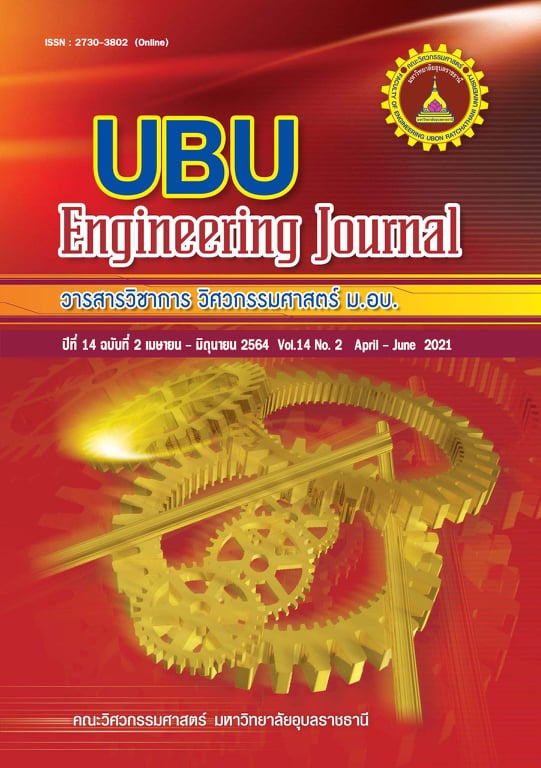Properties of basalt quarry dust mixed with bentonite for landfill liner construction
Main Article Content
Abstract
Basalt quarry dust (BQD) is considered as waste material from basalt milling process. Currently, a large amount of BQD is left over and its use is limited. This paper aimed to study the properties of BQD mixed with bentonite (BQD-B) for using as liner material, and to determine the effect of different compaction energy and compaction moisture content on its properties for construction as landfill liner. The BQD used in this study was obtained from a basalt quarry in Ubon Ratchathani province. It was found that the addition of 1% of sodium-bentonite to the BQD resulted in the reduction of the hydraulic conductivity of the BQD to the level of 1×10-9 m/s, the required hydraulic conductivity for using as landfill liner material. Shear strength of the BQD-B tended to decrease as the compaction moisture content increased, while, the volumetric shrinkage increased as the compaction moisture content increased. The optimum compaction condition for the BQD-B can be obtained with the compaction moisture content of 12.0% - 15.5% and the dry unit weight of 18.6 - 20.5 kN/m3, in order to achieve the acceptable quality for using as liner material with safe bearing capacity and minimum shrinkage potential.
Article Details
References
[2] Iizuka M, Imaizumi S, Toryuu A, Doi Y. Critical ratio of bentonite addition into sandy soil to make a impermeable compacted soil liner. In: 9th Int. Waste Management and Landfill Symposium. Sardinia, Italy; 2003.
[3] Stern RT, Shackelford CD. Permeation of sand-processed clay mixtures with calcium chloride solutions. Journal of Geotechnical and Geoenvironmental Engineering, ASCE. 1998; 124(3): 231-241.
[4] Doi Y, Imaizumi S. Evaluation of permeability of compacted pit sand mixed with bentonite using flexible-wall permeameter. In: 2nd Asian-Pacific Landfill Symposium. Seoul, Korea; 2002. p. 240-246.
[5] Ebina T, Minja RJA, Nagase T, Onodera Y, Chatterjee A. Correlation of hydraulic conductivity of clay-sand compacted specimens with clay properties. Applied Clay Science. 2004; 26(1-4): 3-12.
[6] ทวีศักดิ์ วังไพศาล, นท แสงเทียน. การปรับปรุงดินทรายปนทรายแป้งสำหรับเป็นวัสดุกันซึมในระบบเก็บกักของเสีย. วารสารวิทยาศาสตร์และเทคโนโลยี มหาวิทยาลัยอุบลราชธานี. 2554; 13 (4): 1-13.
[7] กรมอุตสาหกรรมพื้นฐานและการเหมืองแร่. กระทรวงอุตสาหกรรม. ข้อมูลการผลิตแร่ของประเทศ http://www7.dpim.go.th/stat/production.php?pduct=%25&pdcode=009&pdyear1=2018&pdyear2=2018 [เข้าถึงเมื่อ 12 พฤษภาคม 2563]
[8] Laibao L, Yunsheng Z, Wenhua Z, Zhiyong L, Lihua Z. Investigating the influence of basalt as mineral admixture on hydration and microstructure formation mechanism of cement. Construction and Building Materials. 2013; 48: 434-440.
[9] Uncik S, Kmecova V. The effect of basalt powder on the properties of cement composites. Procedia Engineering. 2013; 65: 51-56.
[10] ภาณุพงศ์ จันฤาไชย, รัฐพล สมนา, จีรศักดิ์ สุพรมวัน. กำลังอัดประลัยและการหดตัวแบบแห้งของคอนกรีตที่ใช้หินฝุ่นแทนที่ทราย. ใน: การประชุมวิชาการวิศวกรรมโยธาแห่งชาติ ครั้งที่ 21. มหาวิทยาลัยเทคโนโลยีราชมงคลศรีวิชัย, สงขลา; 2559. หน้า 728-732.
[11] อิทธิพล แก้วบัวดี, เทิดศักดิ์ รองวิริยะพานิช, อัคคพัฒน์ สว่างสุรีย์. การประยุกต์ใช้หินฝุ่นสำหรับงานถมคันทางตามมาตรฐานทรายถมคันทางที่ ทล.-ม. 103/2532. ใน: การสัมมนาเจ้าหน้าที่วิเคราะห์และตรวจสอบ ประจำปีงบประมาณ 2554. สำนักวิเคราะห์และตรวจสอบ กรมทางหลวง; 2554.
[12] ฐิติกรณ์ โพธิ์ศรีบิ้ง, สมบูรณ์ กนกนภากุล, ชยกฤต เพชรช่วย, เชิดศักดิ์ สุขศิริพัฒนพงศ์, ณัฐพงศ์ มกระธัช, วีรพันธุ์ เจียมมีปรีชา. การพัฒนากำลังอัดของหินฝุ่นที่ปรับปรุงด้วยกากแคลเซียมคาร์ไบด์และเถ้าลอย. ใน: การประชุมวิชาการวิศวกรรมโยธาแห่งชาติ ครั้งที่ 21. มหาวิทยาลัยเทคโนโลยีราชมงคลศรีวิชัย, สงขลา; 2559. หน้า 1167-1171.
[13] ดนุพล ตันนโยภาส, วรัญรัตน์ แก้วสมบูรณ์, สุชาติ จันทรมณีย์. คุณลักษณะกระเบื้องเซรามิกผลิตจากหินฝุ่นบะซอลต์ผสมร่วมกับเถ้าใยปาล์มน้ำมัน. วารสารมหาวิทยาลัยทักษิณ. 2553; 12(3): 149-159.
[14] Supkow D. Rock Dust and the Environment (www.stardustersociety.org). 2002. Available from:http://www.lifespirit.org/RDE1.html [Accessed 1st April 2014].
[15] ASTM D698. Standard test methods for laboratory compaction characteristics of soil using standard effort (12,400 ft-lbf/ft3 (600 kN-m/m3)), ASTM International. West Conshohocken: PA; 2012.
[16] ASTM D1557. Standard test methods for laboratory compaction characteristics of soil using modified effort (56,000 ft-lbf/ft3 (2,700 kN-m/m3)), ASTM International. West Conshohocken: PA; 2012.
[17] Daniel DE, Benson CH. Water content-density criteria for compacted soil liners. Journal of Geotechnical Engineering, ASCE. 1990; 116(12): 1811-1830.
[18] ASTM D5856. Standard test method for measurement of hydraulic conductivity of porous material using a rigid-wall, compaction-mold permeameter, ASTM International. West Conshohocken: PA; 2012.
[19] ASTM D5084. Standard test methods for measurement of hydraulic conductivity of saturated porous materials using a flexible wall permeameter, ASTM International, West Conshohocken: PA; 2012.
[20] ASTM D2166. Standard test method for unconfined compressive strength of cohesive soil, ASTM International, West Conshohocken: PA; 2012.
[21] Daniel DE, Wu YK. Compacted clay liners and covers for arid sites. Journal of Geotechnical Engineering, ASCE. 1993; 119(2): 223-237.
[22] USEPA. Technical Manual: Solid Waste Disposal Facility Criteria; EPA/530-R-93-017; Office of Solid Waste and Emergency Response. Washington, D.C. 1993.
[23] Oweis IS, Khera RP. Geotechnology of Waste Management, PWS Publishing; 1998.
[24] Tay YY, Stewart DI, Cousens TW. Shrinkage and desiccation cracking in bentonite-sand landfill liners. Engineering Geology. 2001; 60(1-4): 263 -274.
[25] Kabir MH, Taha MR. Assessment of physical properties of a granite residual soil as an isolation barrier. Electronic Journal of Geotechnical Engineering. EJGE. 2004; 9B. Available from: http://www.ejge.com/2004/ JourTOC9B.htm [Accessed 25th January 2020].

